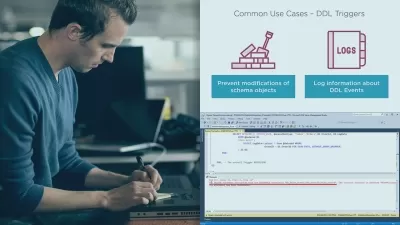Advanced Database Design Patterns in Action
10:37:13
Description
Real Project | Database Design | Normalization | Indexing | Partitioning | Modeling | Security | SQL Server
What You'll Learn?
- 60+ HANDS-ON sessions
- 140+ slides and 20+ sql migrations scripts available for download
- Understand how to choose the right data type for your index
- Choose the right indexing strategy to boost query performance
- Apply advanced data modeling techniques to handle complex data scenarios
- Master table partitioning—both horizontally and vertically—to efficiently manage large datasets
- Design databases for multilingual applications without sacrificing speed
- Model and implement hierarchical data structures for intuitive data organization
- Prevent index fragmentation with smart design choices from the start
- Implement table inheritance to model complex relationships effectively
- Know when to normalize to improve data integrity, and when to denormalize to optimize performance
Who is this for?
What You Need to Know?
More details
DescriptionIn this hands-on course, Advanced Database Design Patterns in Action, we will dive deep into advanced database design techniques that go far beyond the basics. Starting with a basic implementation of an online store database, each lesson will introduce and apply a new design pattern to enhance the database’s speed, data integrity, or scalability. You’ll learn how to implement these advanced techniques in a way that solves real-world problems, enabling you to design highly efficient and robust databases.
What Makes This Course Stand Out:
Advanced Patterns Rarely Covered in Other Courses – This course tackles sophisticated concepts, from indexing strategies and horizontal partitioning to handling hierarchical data and multi-language support, preparing you to think and design like a database architect.
Hands-On, Project-Based Learning – You'll build and optimize a realistic database project, seeing the immediate impact of each pattern and technique on performance and reliability.
Skills for Any RDBMS – While exercises use SQL Server, the principles you’ll learn are valuable across MySQL, PostgreSQL, Oracle, and other platforms.
Topics Covered Include:
Primary Key and Indexing Strategy
Foreign Keys and Constraints
Normalization (1st to 4th Normal Form)
Horizontal and Vertical Partitioning
Hierarchical Data Modeling
Multi-language Data Handling
Soft Deletes, History Tables, Computed Columns
Indexed Views, Precalculated Tables, Statistics, and more!
If you're ready to master patterns that boost performance, scalability, and data integrity, this course will take you to advanced database design mastery.
Who this course is for:
- Database developers and architects who are looking to level up their database design skills with advanced techniques
- Full-stack developers, and junior DBAs who understand basic SQL Server concepts and can write simple SQL queries
- SQL Server professionals who want to optimize performance, scalability, and maintainability in real-world projects
- Software engineers working with large datasets who need to implement effective partitioning and indexing strategies
- Data professionals tasked with designing complex database systems, including support for hierarchical data, multi-language applications, and table inheritance
In this hands-on course, Advanced Database Design Patterns in Action, we will dive deep into advanced database design techniques that go far beyond the basics. Starting with a basic implementation of an online store database, each lesson will introduce and apply a new design pattern to enhance the database’s speed, data integrity, or scalability. You’ll learn how to implement these advanced techniques in a way that solves real-world problems, enabling you to design highly efficient and robust databases.
What Makes This Course Stand Out:
Advanced Patterns Rarely Covered in Other Courses – This course tackles sophisticated concepts, from indexing strategies and horizontal partitioning to handling hierarchical data and multi-language support, preparing you to think and design like a database architect.
Hands-On, Project-Based Learning – You'll build and optimize a realistic database project, seeing the immediate impact of each pattern and technique on performance and reliability.
Skills for Any RDBMS – While exercises use SQL Server, the principles you’ll learn are valuable across MySQL, PostgreSQL, Oracle, and other platforms.
Topics Covered Include:
Primary Key and Indexing Strategy
Foreign Keys and Constraints
Normalization (1st to 4th Normal Form)
Horizontal and Vertical Partitioning
Hierarchical Data Modeling
Multi-language Data Handling
Soft Deletes, History Tables, Computed Columns
Indexed Views, Precalculated Tables, Statistics, and more!
If you're ready to master patterns that boost performance, scalability, and data integrity, this course will take you to advanced database design mastery.
Who this course is for:
- Database developers and architects who are looking to level up their database design skills with advanced techniques
- Full-stack developers, and junior DBAs who understand basic SQL Server concepts and can write simple SQL queries
- SQL Server professionals who want to optimize performance, scalability, and maintainability in real-world projects
- Software engineers working with large datasets who need to implement effective partitioning and indexing strategies
- Data professionals tasked with designing complex database systems, including support for hierarchical data, multi-language applications, and table inheritance
User Reviews
Rating

Udemy
View courses Udemy- language english
- Training sessions 134
- duration 10:37:13
- Release Date 2025/01/23










